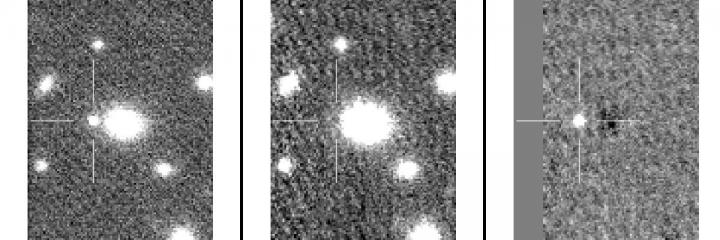
Credit: ANU
Online volunteers, including a woman from Belgium and a Scottish man, have helped astronomers at The Australian National University (ANU) find a star that exploded 970 million years ago, predating the dinosaurs' time on Earth.
ANU has invited everyone with an interest in astronomy to join the University's search for exploding stars called supernovae, which scientists can use to measure the Universe and acceleration of its growth.
Co-lead researcher Dr Brad Tucker said his team was able to confirm a previously unknown object was a real exploding star in just a day, thanks to the efficiency and dedication of volunteer supernovae hunters – more than 700 of them.
"The supernova is about 970 million light years away, meaning that it exploded before the dinosaurs were even on the Earth," said Dr Tucker from the ANU Research School of Astronomy and Astrophysics (RSAA).
"This is the exact type of supernova we're looking for – type Ia supernova – to measure properties of and distances across the Universe."
Among the amateur co-discoverers are Alan Craggs from Aberdeenshire in Scotland and Elisabeth Baeten from Belgium.
Seven potential supernovae have been reported to the Transient Name Server.
"We are tracking 18 other possible exploding stars," Dr Tucker said.
Co-lead researcher Dr Anais Möller said the Ia supernova discovered through the ANU project had already been named.
"Supernovae have boring names – it's called SN2017dxh," said Dr Möller from RSAA.
"We are recognising volunteers by listing the first three people to find a previously unknown supernova in the discovery when we report it to the International Astronomical Union.
"In the first 24 hours we had over 30,000 classifications. We've almost reached 40,000 classifications, with more than 1,300 images classified, since the launch of our project."
Astrophysicists use supernovae, which are explosions as bright as 100 million billion billion billion lightning bolts, as light sources to measure how the Universe is growing and better understand dark energy, the cause of the Universe's acceleration.
Scientists can measure the distance of a supernova from Earth by calculating how much the light from the exploding star fades.
The ANU project allows citizen scientists to use a web portal on Zooniverse.org to search images taken by the SkyMapper 1.3-metre telescope at the ANU Siding Spring Observatory for the SkyMapper Transient Survey.
Citizen volunteers scan the SkyMapper images online to look for differences and mark up those differences for the researchers to follow up.
SkyMapper is the only telescope that is doing a comprehensive survey of the southern sky looking for supernovae and other interesting transient events at these distances.
Watch a video interview with Dr Brad Tucker about the project: youtu.be/NzSG9Ax_e_s
People can to participate in the ANU citizen science project at http://www.zooniverse.org/projects/skymap/supernova-sighting to join the search for exploding stars.
###
FOR INTERVIEW:
Dr Brad Tucker
ANU Research School of Astronomy and Astrophysics
P: +61 2 6125 6711
M: +61 433 905 777
E: [email protected]
Dr Anais Möller
ANU Research School of Astronomy and Astrophysics
P: +61 2 6125 8915
M: +61 422 348 538
E: [email protected]
FOR MEDIA ASSISTANCE:
Will Wright
ANU Media Team
P: +61 2 6125 7979
M: +61 478 337 740
E: [email protected]
Media Contact
Dr. Brad Tucker
[email protected]
61-261-256-711
@ANUmedia
http://www.anu.edu.au/media
############
Story Source: Materials provided by Scienmag





